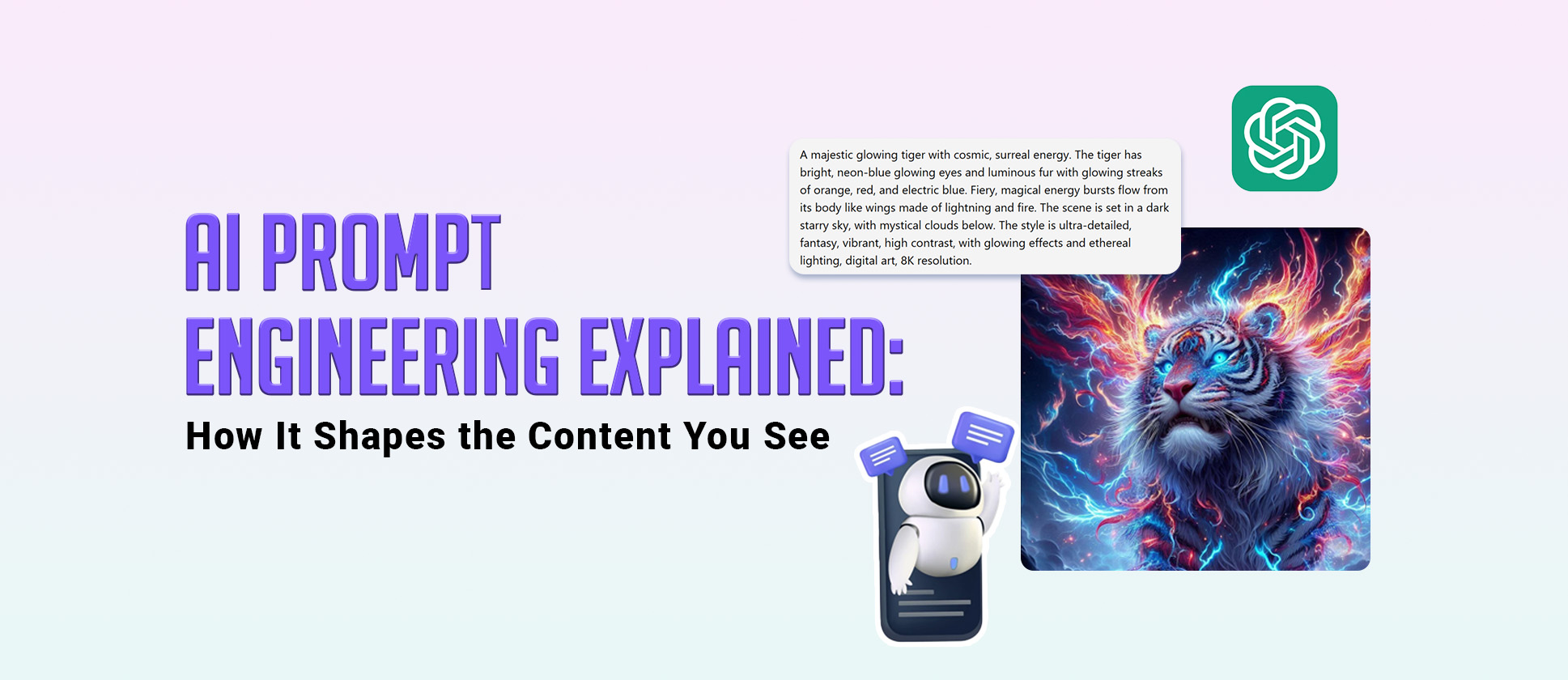Quick Summary
TL;DR: AI Prompt Engineering is the art of crafting precise instructions that guide AI tools to generate accurate, creative, and audience-ready content. By shaping context, tone, structure, and examples, prompt engineering transforms AI from a generic assistant into a creative partner. #tldr
- Key Insights:
Faster Drafts → Stronger Personalization → Creative Spark → Better SEO → Cost Savings → Consistent Branding → Quality Control
- Top Benefit for Content Teams:
With prompt engineering, AI transforms from a writing tool into a creative collaborator, helping brands produce meaningful, engaging content more quickly, intelligently, and cost-effectively.
- Final Takeaway:
Clear, organized prompts improve content quality, speed up production, reduce costs, and maintain a consistent brand voice. This makes AI a valuable tool for creating content today.
What started as simple instructions for AI has evolved into something much bigger. AI prompt engineering now shapes how ideas turn into content that inspires, informs, and connects with real people. Prompts are not random lines of text; they are the difference between dull copy and inspiring content that people actually want to read. It is literally the bridge between regular commands and meaningful conversations with artificial intelligence. Every time an editor or marketer types a question or instruction in ChatGPT or a writing platform, a prompt shapes what comes back. Prompt Tuning for ChatGPT or even GPT-5 led to a 40% increase in task-specific accuracy, emphasizing how refined prompts directly boost output quality.
For a creative team like ShortVids that lives and breathes visuals and words, the importance of AI prompt engineering cannot be overstated. It is the secret element that can make AI content writing sharper, more human-like, and easier for viewers to relate to. Instead of spending hours tweaking drafts or digging through countless edits, we can create detailed, structured prompts that guide AI tools to deliver outputs much closer to the final vision. That means Faster Content Creation with AI without losing the emotional personality or charm that makes a story stick.
What is AI Prompt Engineering and Why Is It Important
Without prompt engineering, AI can spin out generic robotic text that lacks depth, but with the right prompt, it can generate unique content at scale. Every brand that experiments with Content Creation with AI soon learns one big thing: the results depend on the clarity of the prompt. That is exactly where prompt engineering in AI comes into play. It is the practice of shaping instructions so that artificial intelligence tools return answers that are not only factually sharp but also stylistically on point.
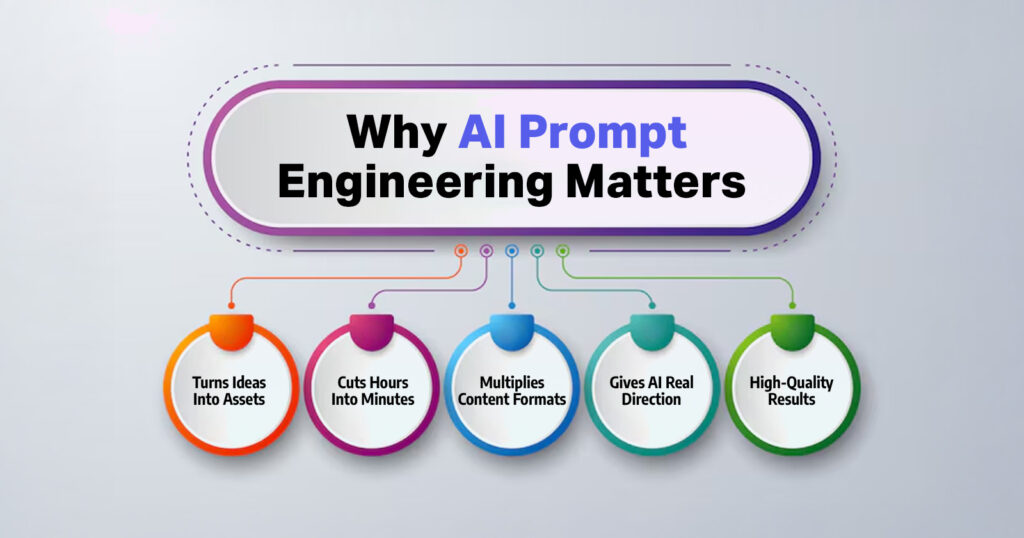
Clear Instructions
Clear instructions always make a difference. Instead of leaving AI to guess what is needed, a detailed prompt narrows down the tone, length, examples, and goals.
For instance, saying “write a 90-word friendly intro about video editing benefits” guides the AI way better than simply asking “write about video editing.”
Context Added
Whether writing blog posts, Creating Scripts, or generating ad copy, context allows AI to mimic a human storyteller. Adding context allows stronger AI Content Generation.
By showing the AI tool who the audience is and what emotion should be felt in the message, the final draft feels more aligned with real-world needs.
Tone Defined
Tone is often ignored, but it decides whether words connect or fall flat. This ensures AI writing prompts always bring back the right voice for the brand or Campaign.
Through prompt engineering, a creator can explain if a piece should sound casual, adventurous, professional, or even funny.
AI Prompt Engineering Role in Content Creation
In the landscape of AI content writing, prompt engineering cuts trial-and-error short and allows ideas to scale faster. AI prompt engineering sits at the heart of every Modern Marketing workflow. Without it, teams often see AI Tools produce surface-level writing, but with it, AI can transform into a creative partner.
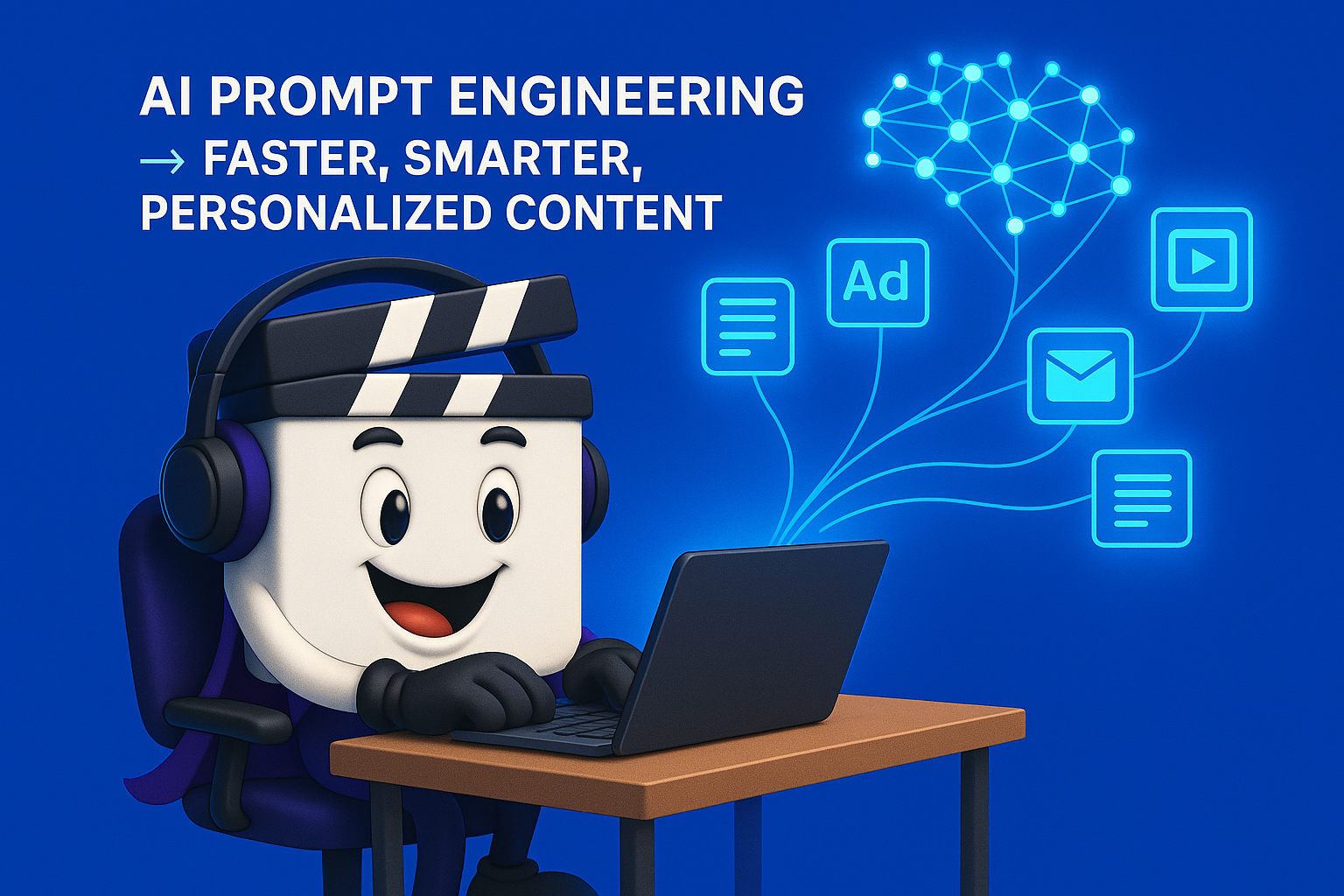
Faster Drafts
Well-structured prompts mean the AI generates drafts quickly, and those drafts are already close to publish-ready. AI can produce press Release Drafts up to 5× faster than human writers. What takes 2–3 hours for a human is generated in under 30 minutes by AI. Not only does this cut rewriting time, but it also ensures campaigns launch faster.
Stronger Personalization
Not all audiences are the same. Using prompt engineering, Marketers can ask AI to write for specific age groups, industries, or even regional styles. That detail personalizes blogs, Ad Creatives, and captions in a way that simply feels more relatable. Here’s how you can personalize your prompt:
- Specify the target age group (e.g., Gen Z, millennials, baby boomers) to adjust tone and references.
- Define the industry or profession (e.g., tech, healthcare, education) for relevant jargon and examples.
- Include geographic or cultural context (e.g., US audiences, European trends, Asian markets) to reflect local preferences.
- Tailor the content format (e.g., casual social media posts, formal blog articles, email newsletters) for the appropriate style.
- Indicate user intent or need (e.g., beginners looking for tips, experts seeking deep insights) to focus the message.
- Control emotional tone (e.g., inspiring, humorous, empathetic) to resonate emotionally with the audience.
- Request inclusion of specific keywords or phrases relevant to the niche or campaign goals.
- Adjust content length or complexity based on audience education level or attention span.
These prompt engineering strategies make AI content generation feel more personalized, relatable, and effective for varied audiences.
Creative Spark
A study by the University of Exeter found that access to five AI-generated story ideas improved novelty ratings by 8.1% and usefulness ratings by 9%, compared to those without AI assistance. Even professional creators face a creative block. AI content generation, prompted correctly, can suggest fresh headlines or storytelling angles that a human might overlook. This keeps campaigns from recycling stale ideas.
Tips for Effective Prompt Engineering
Having prompts that just work every time takes practice. There are proven ways to make AI writing prompts sharper and more reliable so results feel less random and more strategic.
Specific Details
Tell the AI exactly what to do. Instead of “write about social media,” say “write a 150-word blog paragraph explaining why short-form videos get higher engagement on TikTok.” Specifics make the AI’s job smooth. Specificity removes guesswork and ensures the AI produces exactly what you need.
General Prompt: “Create an image of a cat.”
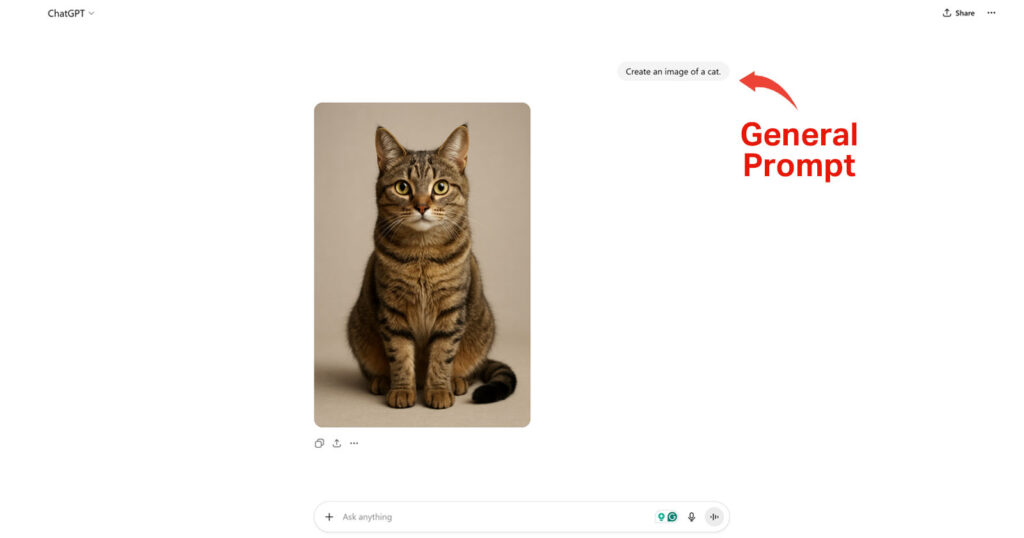
Better Prompt: “Create a detailed image of an orange cat sitting on a wooden fence under a clear blue sky, in a bright and cheerful style.”
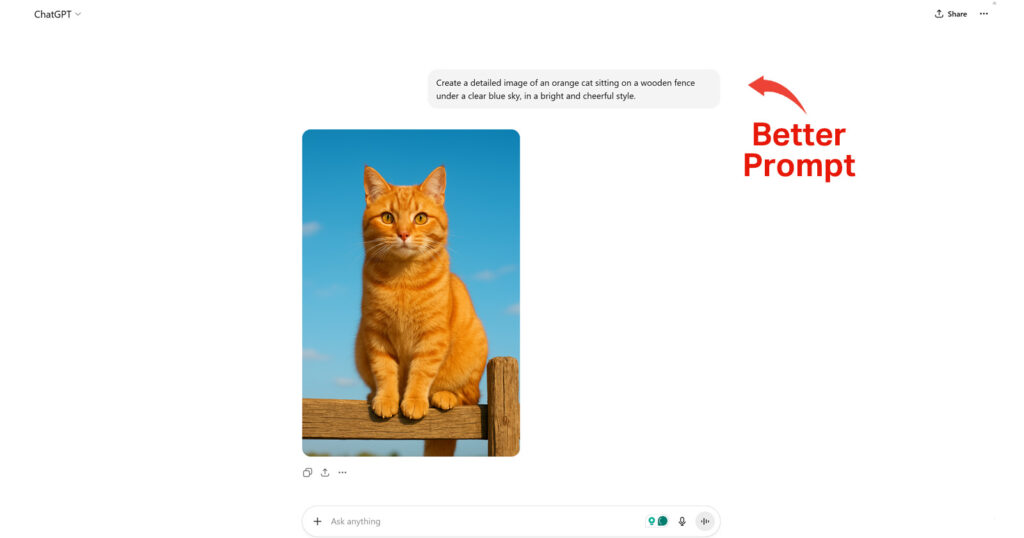
Step by Step
A prompt that first asks for points, then requests detailed paragraphs, builds content layer by layer without confusion. Breaking down output into steps makes AI more accurate.
Example Prompt Structure:
- “List 5 reasons short-form video is effective for marketing.”
- “Now expand each point into a 120-word paragraph with examples.”
Use Examples
Adding examples inside prompts works like magic. If the AI sees a style of writing or structure, it can mimic it and keep things consistent across blogs, scripts, or emails. For example, “Here’s a sample email format I like: [Insert Example]. Now write a similar email promoting my webinar on AI tools for small businesses.” AI can mimic tone, structure, and flow when examples are provided.
Real World Benefits of AI Prompt Engineering
The truth is that the benefits of prompt engineering in AI flow directly into bigger returns and Smoother Workflows for creative teams. But still, the real question businesses ask is not just “what is prompt engineering” but “why should anyone care.”
Better SEO
AI trained with stronger prompts adds targeted keywords naturally and organizes content with headings that search engines actually love. That means blogs rank higher in search, which leads to more clicks and shares. See how stronger prompts improve SEO and save costs:
- Embed targeted keywords naturally in prompts to avoid keyword stuffing and enhance readability.
- Guide AI to create clear, descriptive headings that improve content structure and search engine crawling.
- Request inclusion of related long-tail keywords and questions to capture broader search intent.
- Ask AI to write concise meta descriptions and alt text for images, optimizing overall page ranking.
- Use prompts to ensure content answers common user queries directly, boosting featured snippet chances.
Learn: How you can rank your Long Videos higher on YouTube and Google.
Cost Savings
Instead of hiring multiple writers for the same repetitive tasks, Businesses can rely on AI content writing powered by solid engineering. It saves budget while still giving the team capacity to focus on high-value creative work. In fact, studies show generative AI can cut content creation time by up to 80%. This means big savings on labor costs, and there’s more:
- Automate repetitive writing tasks like product descriptions, social media posts, and newsletters with AI.
- Reduce reliance on large content teams by generating drafts that only need light editing.
- Cut turnaround times drastically, allowing faster campaign launches and more content output.
- Free up creative teams to focus on strategy and high-impact storytelling rather than routine tasks.
- Studies indicate generative AI can reduce content creation time by up to 80%, leading to major labor cost savings.
- These prompt engineering techniques make AI content writing both more efficient and cost-effective for businesses.
Consistent Branding
Well-planned prompts teach AI to remember tone and brand voice. Across blogs, Paid Ads, and captions, the team’s output stays consistent, which builds long-term trust with the audience. How AI prompt engineering can build consistent branding:
- Define the brand’s tone and voice clearly in the prompt (e.g., friendly, professional, adventurous) for uniform expression.
- Include examples of past content or style guidelines within prompts to guide AI writing style.
- Use branded keywords and phrases repeatedly to reinforce brand messaging and identity.
- Specify formatting preferences like heading styles, sentence length, and vocabulary to maintain visual and verbal consistency.
- Request AI to align content with brand values and mission in every piece to keep messaging coherent.
- Create prompt templates that standardize output structure and tone across different content types like blogs, ads, and captions.
- Regularly refine prompts based on performance feedback to keep the brand voice fresh but consistent over time.
Quick Comparison of Prompt Quality
Here is how AI responds when the prompt engineering effort is low versus high.
| Prompt Style | AI Output Result | Impact on Content |
|---|---|---|
| Vague one-line prompt | Generic, repetitive, lacking originality | More editing needed |
| Specific context prompt | Detailed, audience-focused, natural voice | Saves time, drives engagement |
| Step-based structured | Organized, logical, SEO-ready | Directly usable for campaigns |
| Example-driven prompt | Stylistically aligned, consistent tone | Strong brand match |
What Makes a Prompt Good or Bad in AI Content Creation
Understanding what makes a prompt good or bad is crucial for tapping into the full power of AI prompt engineering. Not all prompts deliver the same results, and small differences can totally change the quality of output.
Think of a good prompt as a clear director guiding the AI step-by-step, while a bad prompt is more like a vague suggestion, leaving too much room for error, but knowing which prompt is good or bad itself is a major Content Creation Challenge. So let’s look at the characteristics of good and bad prompts.
Characteristics of a Bad Prompt
A bad prompt tends to be vague or too broad. It often:
- Uses generic phrases like “write about AI” without setting clear goals or a format.
- Lacks audience or style context, making AI guess what tone or approach to use.
- Misses instructions on content length or structure, resulting in scattered output.
- Packs too many unrelated ideas into one prompt, confusing the AI.
- Ignores keyword or organization needs, which hurts SEO and readability.
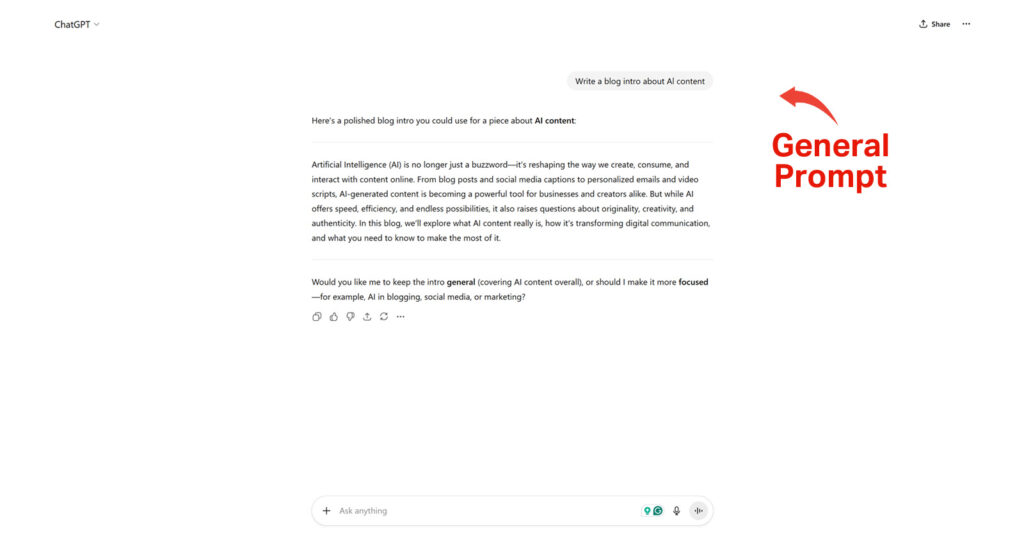
For instance, a prompt like:
“Write a blog intro about AI content.”
It is too open-ended. It can produce robotic, unfocused text that needs lots of rewriting.
Characteristics of a Good Prompt
A good prompt is clear, detailed, and well-organized. It usually:
- Specifies the type of content and desired length so the AI knows what to produce.
- Gives context about the audience or purpose to shape tone and focus clearly.
- Includes examples or templates to guide style and format naturally.
- Breaks complex tasks into simple step-by-step instructions for better accuracy.
- Mentions keywords or phrases that should be included in a way that fits the flow.
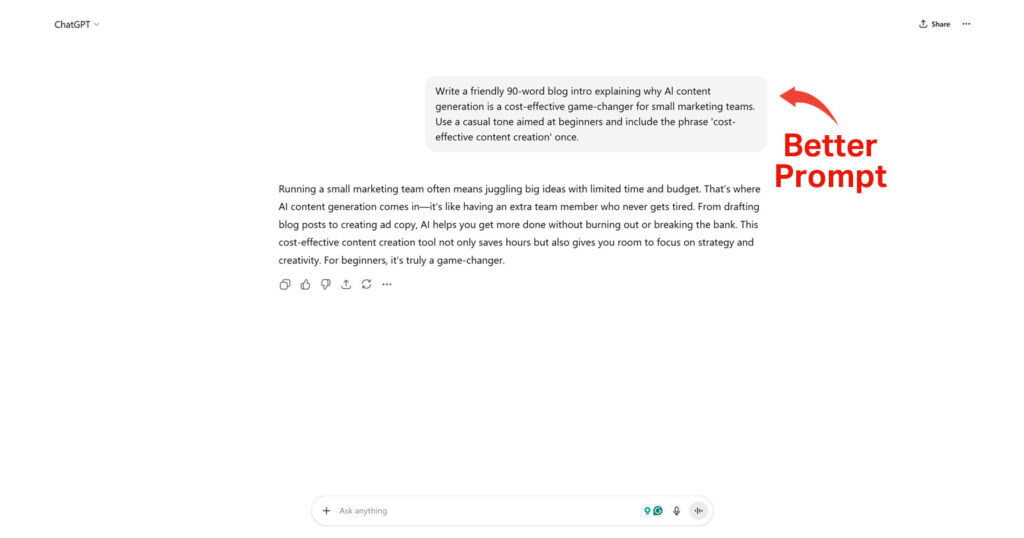
For example, when creating content for a team like the one behind ShortVids, a good prompt might be:
“Write a friendly 120-word blog intro explaining why AI content generation is a cost-effective game-changer for small marketing teams. Use a casual tone aimed at beginners and include the phrase ‘cost-effective content creation’ once.”
This kind of prompt helps the AI deliver content that feels relevant, on point, and easy to use right away.
Factors That Affect Prompt Quality
Besides clarity and detail, a few less obvious points make a big difference:
- Avoid Overloading: Too many instructions can overwhelm AI and reduce focus. Splitting requests into smaller prompts often works better.
- Use Conversational Language: Natural, relaxed phrasing makes AI respond with content closer to human style.
- Iterate and Refine: Prompt engineering is a back-and-forth process. Adjusting prompts after seeing AI output improves results gradually.
- Balance Prompt Length: Very short prompts lack guidance, but overly long prompts can tire the AI’s focus. Around 30 to 60 words is usually best.
Even for a Video Production Company like ShortVids that already has experienced content writers writing scripts and stories, mastering these prompt details has made a big difference. While ShortVids doesn’t completely rely on AI for all writing needs, leveraging well-written prompts helps speed up the process and produce copy that closely fits the Brand’s Voice and goals every single time.
Final Thoughts
The essence of AI prompt engineering lies in shaping instructions in ways that AI tools understand and respond naturally. From AI writing prompts that generate blog intros to structured guides for brand voice, every good campaign benefits. With the right approach, it speeds up content creation with AI, sparks creative breakthroughs, keeps tone consistent, and even saves costs. As teams like ShortVids lean on these methods, the art of AI content writing becomes less about fixing robotic drafts and more about telling unique, creative stories that actually connect.
Frequently Asked Questions
AI prompt engineering is the practice of creating precise instructions that guide AI tools to produce clear, relevant, and engaging content. It improves content creation with AI by making outputs more accurate, creative, and aligned with specific goals, saving time and effort in editing.
Prompt engineering in AI ensures that AI understands context, tone, and structure, which helps generate blog posts that feel natural and well-organized. Without it, AI may produce generic or robotic content that requires heavy revisions.
Avoid vague commands, overly broad instructions, or too many conflicting requirements in one prompt. Also, don’t skip adding context, tone guidance, or examples, as they are crucial for meaningful AI output.
Even though ShortVids has experienced writers, their team uses prompt engineering to speed up creating scripts and marketing copy that closely match brand voice and campaign goals without fully relying on AI.
Book a Call Today
- Fixed monthly plans starting at $999
- 24-hour turnaround time (or less) on all short-form edits
- 3-layer quality check system on every video
- No more chasing freelancers or managing editors
- Scale up to 50+ videos/month without hiring in-house
- Content team trained on platform trends, scroll-stopping hooks & storytelling
- Fully managed by professionals – you just upload & approve
- Response time: Under 1 hour (US & GCC time zones)
Cut your production costs, not your standards.

